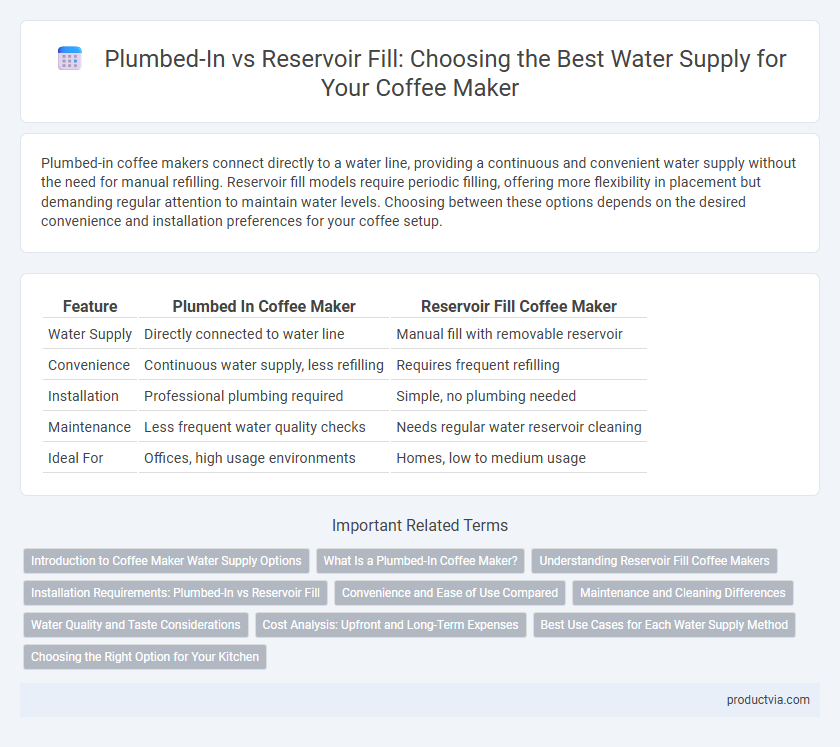Plumbed-in coffee makers connect directly to a water line, providing a continuous and convenient water supply without the need for manual refilling. Reservoir fill models require periodic filling, offering more flexibility in placement but demanding regular attention to maintain water levels. Choosing between these options depends on the desired convenience and installation preferences for your coffee setup.
Table of Comparison
| Feature | Plumbed In Coffee Maker | Reservoir Fill Coffee Maker |
|---|---|---|
| Water Supply | Directly connected to water line | Manual fill with removable reservoir |
| Convenience | Continuous water supply, less refilling | Requires frequent refilling |
| Installation | Professional plumbing required | Simple, no plumbing needed |
| Maintenance | Less frequent water quality checks | Needs regular water reservoir cleaning |
| Ideal For | Offices, high usage environments | Homes, low to medium usage |
Introduction to Coffee Maker Water Supply Options
Coffee makers offer two primary water supply options: plumbed-in and reservoir fill, each catering to different user needs. Plumbed-in coffee makers connect directly to a water line, providing continuous water flow for high-volume brewing, ideal for commercial or office settings. Reservoir fill models require manual water addition, offering flexibility and ease of use for home environments or low-volume coffee preparation.
What Is a Plumbed-In Coffee Maker?
A plumbed-in coffee maker is directly connected to a water supply line, eliminating the need for manual refilling. This setup ensures a continuous water flow, ideal for high-volume environments like offices or cafes. Compared to reservoir fill models, plumbed-in machines offer consistent water pressure and convenience, reducing downtime and maintenance.
Understanding Reservoir Fill Coffee Makers
Reservoir fill coffee makers require manual filling of the water tank, offering flexibility and ease of use without the need for plumbing connections. This type is ideal for users seeking a portable or simple setup, as it requires periodic refilling but avoids the complexities of plumbing installation. Understanding reservoir fill systems highlights convenience for home or office environments where direct water supply is unavailable or impractical.
Installation Requirements: Plumbed-In vs Reservoir Fill
Plumbed-in coffee makers require professional installation with direct connection to the building's water supply, ensuring a continuous water flow and reducing the need for manual refills. Reservoir fill coffee makers feature a removable water tank that must be manually filled, offering flexibility and simpler setup without plumbing modifications. Choosing between these options depends on kitchen layout, water source accessibility, and desired convenience for consistent coffee brewing.
Convenience and Ease of Use Compared
Plumbed-in coffee makers offer unmatched convenience by directly connecting to the water supply, eliminating the need for manual refills and ensuring a continuous water flow for uninterrupted brewing. Reservoir fill models require frequent refilling, which can be less efficient and more time-consuming, especially in high-usage environments. Users prioritizing ease of use in busy settings often prefer plumbed-in systems for their seamless operation and reduced maintenance.
Maintenance and Cleaning Differences
Plumbed-in coffee makers require regular inspection and professional servicing to prevent mineral buildup and ensure consistent water flow, reducing the risk of clogging. Reservoir fill machines need frequent manual refilling and thorough cleaning of the water tank to avoid mold and bacterial growth. Both systems benefit from descaling, but reservoir units demand more hands-on maintenance to maintain optimal hygiene and performance.
Water Quality and Taste Considerations
Plumbed in coffee makers ensure a consistent water supply with potential for filtration systems that improve water quality, reducing impurities and enhancing coffee taste. Reservoir fill models rely on manually added water, which allows users to control the source and quality, but may introduce variability and risk of stale water affecting flavor. Optimal taste depends on water quality management, with plumbed systems offering convenience and reservoir models offering flexibility.
Cost Analysis: Upfront and Long-Term Expenses
Plumbed-in coffee makers typically require higher upfront installation costs due to plumbing work but offer lower long-term expenses with a continuous water supply and reduced manual refilling. Reservoir fill models have minimal initial costs but demand frequent water refills, potentially increasing maintenance time and operational expenses over time. Evaluating usage frequency and convenience needs is crucial in determining the most cost-effective option for both residential and commercial settings.
Best Use Cases for Each Water Supply Method
Plumbed-in water supply systems are ideal for high-volume settings like offices or cafes where continuous water flow ensures uninterrupted coffee brewing. Reservoir fill coffee makers suit home users or small offices where flexibility and ease of setup are priorities, allowing manual refilling without plumbing modifications. Understanding the specific usage environment and frequency helps in selecting the most efficient water supply method for optimal performance and convenience.
Choosing the Right Option for Your Kitchen
Choosing between a plumbed-in coffee maker and a reservoir-fill model depends on your kitchen's layout and usage needs. Plumbed-in machines offer continuous water supply and streamline brewing for high-demand environments, while reservoir-fill units provide flexibility and easier installation without permanent plumbing. Assess your daily coffee volume and available water connections to select the optimal solution that maximizes convenience and efficiency.
Plumbed In vs Reservoir Fill for Water Supply Infographic

 productvia.com
productvia.com